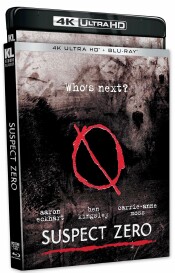“I know what you’re thinking. “Pain is coming. Will I take it like a man?” Well, let me put you at ease. You won’t — but none of them do. Men, women, children, they all weep, they all beg, they pass out, they piss themselves, they attempt negotiation. You wouldn’t believe how many men I’ve seen lying right where you’re lying right now, grown men with wives and children at home, offering all kinds of sexual gratification for a five-minute reprieve. It’s pathetic.”
Suspect Zero follows the contradictory teacher/student relationship between serial killer Benjamin O’Ryan (Ben Kingsley) and FBI Agent-in-Pursuit Tom Mackelway (Aaron Eckhart, sporting as much chin as Bruce Campbell). O’Ryan is a tormented refugee of a government program to tap psychic powers for military intelligence, and Mackelway is a borderline-rogue agent, tormented by visions and headaches. Without letting slip any spoilers, the movie sees O’Ryan draw their paths together in pursuit of justice for himself, his victims, and Mackelway.
Kingsley does a typically stand-up job playing O’Ryan, who comes across alternately as heroic, demented, charismatic, and alarming. Carrie-Anne Moss’s character seems to have been thrown in to get her name on the playbill – adding some more contemporary star power, and perhaps drawing in a different demographic than might be suggested by Kingsley’s lead role. Moss seems uninspired in her role, delivering lines with the same insipid, insouciant monotone as in The Matrix, and failing overall to bring much emotion to the screen.
Moss aside, the movie is an enjoyable evening’s entertainment, which blends a fairly typical murder mystery with enough from the paranormal and government conspiracy camps to generate some interesting conversation. It’s not the sort of groundbreaking film that stays with you (like Se7en or 12 Monkeys), but it is an enjoyable, dark adventure that I’d put on the shelf next to Kiss the Girls.
Video
Suspect Zero is presented in its original aspect ratio of 1.85:1. The ultra-high-definition image presentation is arrived at with an HEVC codec at an average of 60 mbps. The film was shot on 35mm, so is native 4K. There is an obvious upgrade from the earlier disappointing Blu-ray. Colors are much more saturated, with a far more atmospheric result. You can thank the better contrast and inkier black levels for most of that upgrade. Atmosphere is the best thing this film has going for it. Those cold, saturated colors and wonderful contrast of night sky and snow are truly a sight to behold, and suddenly the film has that creepy effect on the audience once again. Lighting is one of the ways the film achieves that feel, and finally I believe I’m seeing what was always intended.
Audio
The DTS-HD 5.1 track isn’t quite the upgrade. There are some serious dropouts here that I can’t quite figure out. At times it all works so well and the surrounds help nourish all of that atmosphere I’m talking about, and suddenly a huge dip in everything. Dialog comes through just fine, and this isn’t intended to be an aggressive surround mix, but no improvement over what came before … sadly.
Director E. Elias Merhige’s Commentary: I’ll start with the best feature first: Merhige speaks as an auteur and offers a truly first-class commentary to accompany the film. Many commentaries seem to get lost in the mundane details of a given shoot – the heat of the sun in a desert scene, or how a shot was taken at a particular angle. Merhige sticks to his territory – which is artistic, inspired direction. In the light of contemporaries like Se7en or Memento, Suspect Zero stands as a good, but fundamentally unexceptional peer until you listen to this commentary and get an understanding of the level of thought that went into each scene. Merhige deconstructs each shoot’s artistic and philosophical components, and also frequently contextualizes them within the framework of the entire file – other directors, take note. A commentary gives a director (or cast or crew member, for that matter) a real opportunity to commune with the viewer and communicate their vision; Merhige’s success at doing so makes other films’ rambling and inane commentaries seem really pointless in comparison. The only complaint I have is that Merhige’s measured pace and sonorous voice nearly put me to sleep.
Special Features
The extras are found on the Blu-ray.
Remote Viewing Demonstration: (10:32) If you expect director E. Elias Merhige to be able to sit down with a past-prime Army Intelligence-type fellow and successfully conduct a remote viewing, you’ll be disappointed. The cast and crew do a fine job of getting sufficiently amazed about the vague coincidences between Merhige’s viewing and the wanderings of the Outboard Team, but fundamentally, this is as hokey a hocus-pocus exercise as has ever been done. Ultimately, this feature was just boring, self-important, and irrelevant. Save your time.
Four Part Featurette – What We See When We Close Our Eyes: (30:41) Fluff, apparently. When the Taoist monk and his interpreter came on screen, I thought they might be able to save these cheesy PR pieces from complete inanity by offering a different, more spiritual perspective on remote viewing and psychic phenomenon. My hope was dispelled when the interpreter hugely rolled her eyes before starting in on what the monk has just said, which – on par with the rest of these – was a bunch of mumbo-jumbo with no clear intent other than to try to imbue this whole production with a vague aura of pseudo-medical and spiritual credibility. Thumbs down on these.
Final Thoughts:
Ben Kingsly delivers another master class in acting here. Combine his performance with the atmosphere, and the film plays out better than I remembered it. That has a lot to do with the image presentation upgrade here, and this is absolutely worth a double-dip. That 4K transfer has some sweet moments. “Would you like to see them?”
Parts of this review were written by Rod Edwards.





